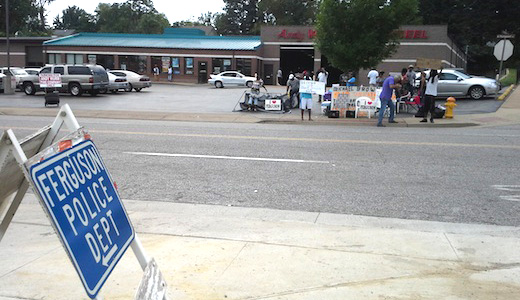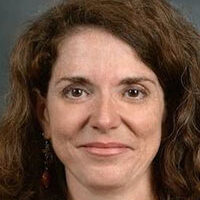
FERGUSON, Mo. – Two and a half miles separate two worlds here: one on South Florissant Road and the other on West Florissant Ave., also known as Ground Zero. Mass protests and police violence, in the wake of what many call the murder of an unarmed Black teenager, Michael Brown, by a white police officer, Darren Wilson, Aug. 9, have taken place on W. Florissant. But protests of a different kind have and are taking place on S. Florissant as well – right across the street from the Ferguson Police Department headquarters.
W. Florissant has all the markings of a working-class main street with its all-night Chinese restaurant, fast-food chains Taco Bell and McDonald’s, an Auto Zone, and locally owned meat market, liquor and grocery stores. While S. Florissant boasts its own share of fast food and auto parts, it also has a public library, banks, a wine bar and a micro-brewery – all the hallmarks of so-called upscale America.
Yet even the manicured hedges along S. Florissant could not block the community’s response to the outrageous killing, and the police department’s attempts to cover-up and other manipulations. Every day since the killing, residents have held a vigil across the street from the police department. Holding signs and sitting in lawn chairs, these protesters – mostly African American, many older – carry on away from TV cameras, and ironically, the heavily armed robo-cops. Even when there was a midnight curfew, it was reported that these protesters stood their ground without interference from law enforcement.
A tent – the kind you would take camping to eat in and avoid the mosquitoes – stands in the far corner of a local business, Andy Wurm Tire and Wheel. People sit in there to take a break from the relentless sun, and to store bottles of water. One woman said the owner (presumably Andy Wurm) had given permission for the protesters to use the property and is well known among African American residents. “He’s got a relationship with the black community,” she said.
As the afternoon sun began to lengthen the shadows, another woman comes to join the vigil. Pushing a baby stroller with her rescue dog in it and a sign that reads “Paws up, don’t shoot,” she places her chair on the sidewalk among the “I [heart] Ferguson” signs. She told us about the obstacles she had to overcome in helping her dog overcome the trauma in his pre-rescue life. At the same time three men come up with Little Caesars Pizza slices, offering them to protesters and journalists alike. They had come from Los Angeles and Cleveland, Ohio, to show support for the Ferguson community, Mike Brown’s family, and the fight for justice. Wearing a “Random acts of kindness” shirt, the pizza-giver said he wrote comedy scripts in L.A. and proceeded to show why he was a comedy professional.
This crowd holding vigil may not have been as big as those that march at night on W. Florissant that have captured so much media attention, but they are just as concerned and passionate and organized. The two different scenes – W. Florissant and S. Florissant – could be compared to two different kinds of athleticism: sprint and long distance. The W. Florissant protests exploded the fight for justice for Mike Brown and all victims of police crimes and racism into the national consciousness. The S. Florissant protests proceed at a pace sustainable for longer periods of time. Both types are necessary for any track or swim team.
To add one more dimension to the community response, up the road on S. Florissant, stood Amanda Pope, grandmother of a student at the Ferguson-Florissant school district, holding another sign, “Teachers here to teach.” Along this stretch, black and white volunteers hold the signs outside the library and a church, both sites for “vacation school” for public school students whose first day of school, Aug. 14, was postponed in the wake of the killing. Banding together, teachers, parents, grandparents, and local volunteers set up art, music, and computer classes to keep the children “motivated” and “involved” during the day, Pope said.
The school cancellation – opposed by some in the community as an over-reaction by the school board – created numerous problems for working parents and disappointed students. “My grandchild is a student and they asked me if I could volunteer, and I said ‘What do you want me to do?'” Pope said. “Kids were so disappointed that they couldn’t get to school the first day of school. Kids were devastated that ‘I can’t go to school.'”
Pope said the first day there were 40 students at the public library, and “today there are hundreds.” So many that they set up another location at the church. One teacher – a music educator – walked down from the library with a school aide and the aide’s grandchild, a fourth grader, to set up class for the overflow. The teachers in the local district are members of the National Education Association.
The fourth grader said the postponement was a let down for her. “The night before [the first day] I couldn’t really go to sleep so I’d wake up in the middle of night saying I can’t go to bed waiting for school. I woke up at nine and I was like ‘Am I late for school?’ But grandma said we wouldn’t have school for another week. So that’s really sad that I can’t go to school and learn. But now I can,” she said, referring to the volunteer-run school.
This type of community effort – pulling together, volunteering and pitching in when city leaders seemed unable or unwilling to – just added to the unity building, across race, socio-economic and residential lines, during a time of profound crisis.
Photo: Teresa Albano/PW.

MOST POPULAR TODAY

Zionist organizations leading campaign to stop ceasefire resolutions in D.C. area


High Court essentially bans demonstrations, freedom of assembly in Deep South

Afghanistan’s socialist years: The promising future killed off by U.S. imperialism

Communist Karol Cariola elected president of Chile’s legislature






Comments